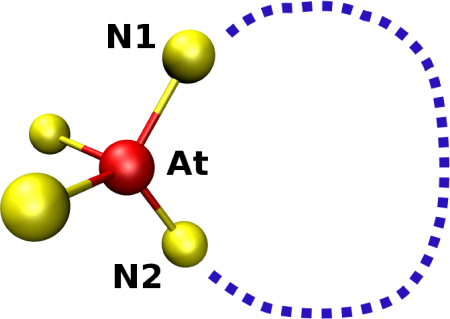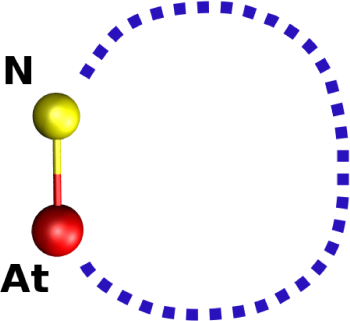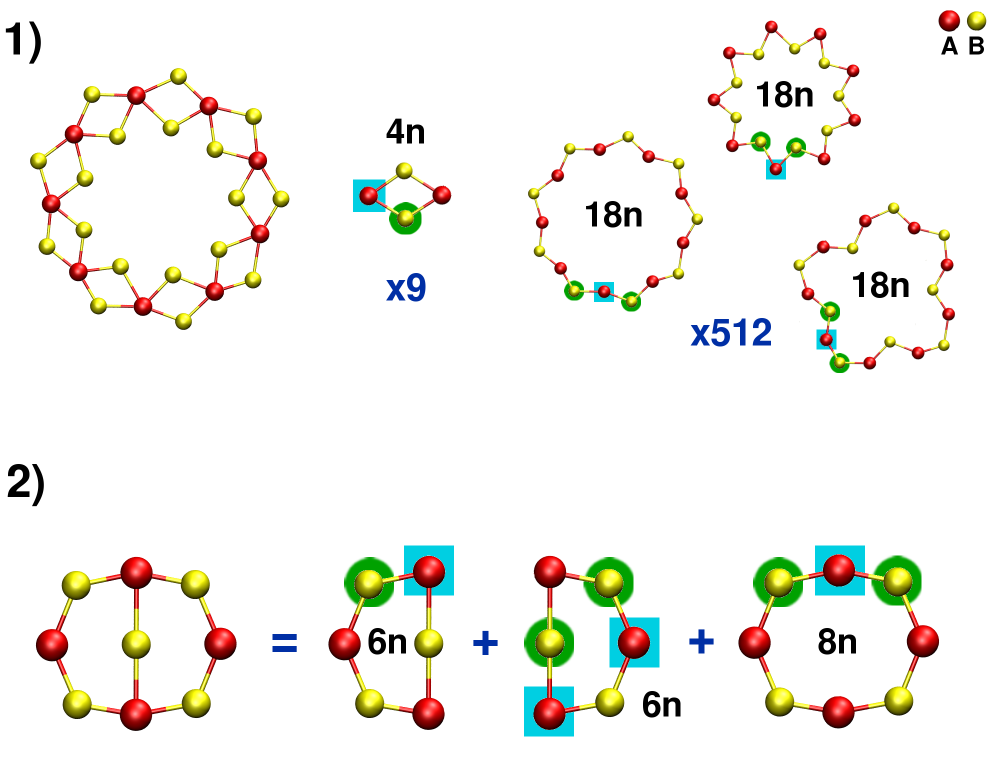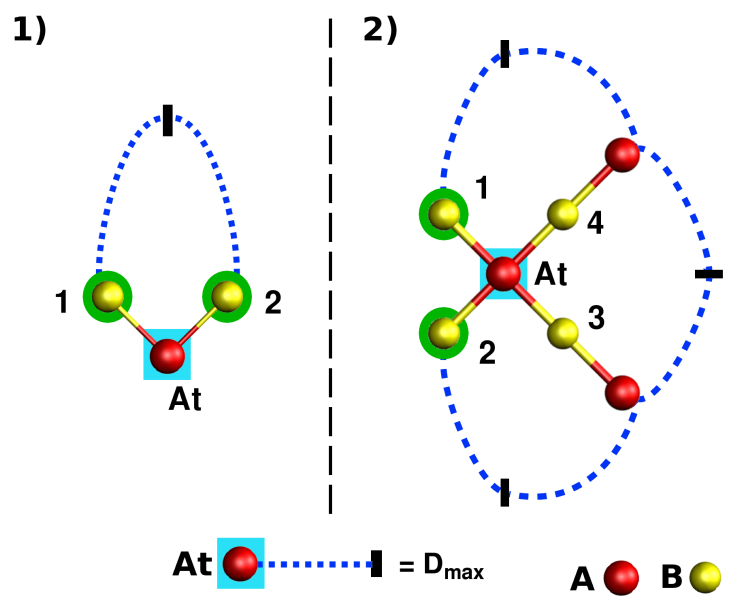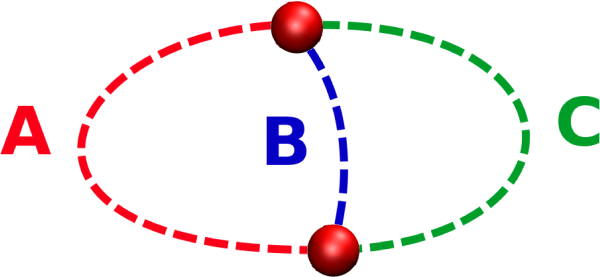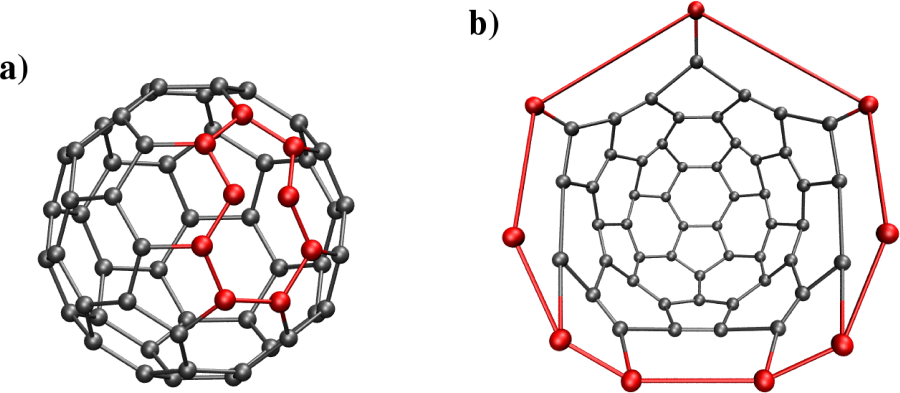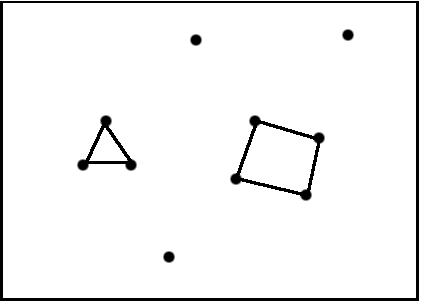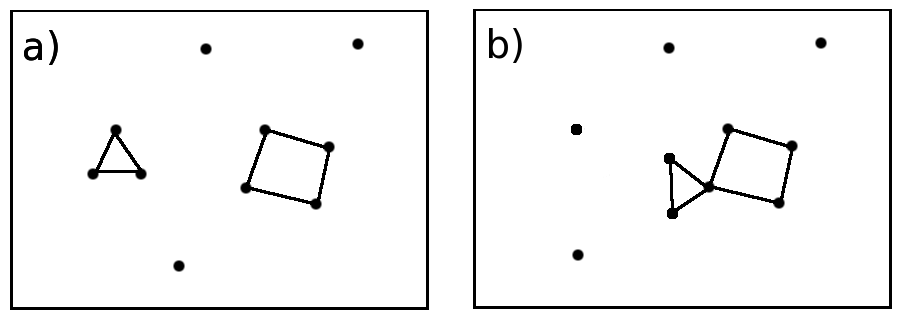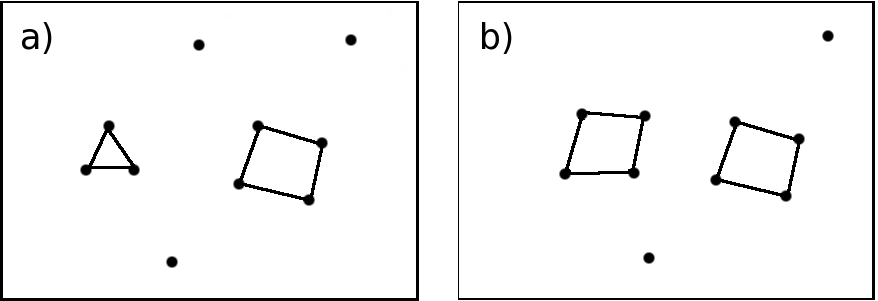The analysis of topological characteristics of network materials (liquids, crystalline or amorphous systems) is often based on the graph theory using nodes for the atoms and links for the interatomic bonds. The absence or the existence of a link between two nodes is determined by the analysis of the total and partial radial distribution functions of the system.
In a network materil a series of nodes and links connected sequentially without overlap is called a path. Following this definition a ring is therefore simply a closed path.
If we study thoroughly a specific node of a network we can see that this node can be involved in numerous rings.
Each of these rings is characterized by its size and can be classified based upon the relations between the nodes and the links which constitute it.
Size of the rings
There are two possibilities for the numbering of rings.
On the one hand, one can use the total number of nodes of the ring, therefore a N-membered ring is a ring containing N nodes.
One the other hand, one can use the number of network forming nodes (ex: Si atoms in SiO2 and Ge atoms in GeS2 which are the atoms of highest coordination in these materials) an N-membered ring is therefore a ring containing 2×N nodes.
For crystals and SiO2 -like glasses the second definition is usually applied.
Nevertheless the first method has to be used in the case of chalcogenide liquids and glasses in order to count rings with homopolar bonds (ex: Ge-Ge and S-S bonds in GeS2) - See "bond defects in ring statistics" for further details.
From a theoretical point of view it is possible to obtain an estimate for the ring of maximum size that could exist in a network.
This theoretical maximum size will depend on the properties of the system studied as well as on the definition of a ring.
Definitions
King's shortest path criterion
The first way to define a ring has been given by Shirley V. King [a] (and later by Franzblau [b]). In order to study the connectivity of glassy SiO2 she defines a ring as the shortest path between two of the nearest neighbors of a given node [Fig. 1].
Inb the case of the King's criterion, one can calculate the maximum number of different ring sizes, NSmax (KSP), which can be found using the atom At to initiate the search:
where Nc (At) is the number of neighbors of atom At.
NSmax (KSP) represents the number of ring sizes found if all couples of neighbors of atom At are connected together with paths of different sizes.
It is also possible to calculate the theoretical maximum size, TMS(KSP), of a King's shortest path ring in the network using:
where Dmax is the longest distance, in terms of chemical bonds, separating two atoms in the network, and Ncmax represents the average number of neighbors of the chemical species of highest coordination.
If used when looking for rings, periodic boundary conditions have to be taken into account to calculate Dmax.
The relation [Eq. 2] is illustrated in figure [Fig. 4].
Guttman's shortest path criterion
A later definition of ring was proposed by Guttman [c], who defines a ring as the shortest path which comes back to a given node (or atom) from one of its nearest neighbors [Fig. 2].
Figure 1: Guttman's criterion in the ring statistics: a ring represents the shortest path which comes back to a given node (At) from one of its nearest neighbors (N).
Like for the King's criterion, it is possible in the case of the Guttman's criterion to calculate the maximum number of different ring sizes, NSmax (GSP), which can be found using the atom At to initiate the search:
where Nc (At) is the number of neighbors of atom At. NSmax (GSP) represents the number of ring sizes found if the neighbors of atom At are connected together with paths of different sizes.
It is also possible to calculate the Theoretical Maximum Size, TMS(GSP), of a Guttman's shortest path ring in the network using:
where Dmax represents the longest distance, in terms of chemical bonds, separating two atoms in the network.
If used when looking for rings, periodic boundary conditions have to be taken into account to calculate Dmax.
The relation [Eq. 4] is illustrated in figure [Fig. 4].
Differences between the King and the Guttman shortest path criteria are illustrated in figure [3].
Figure 3: Differences between the King and the Guttman shortest path criteria for the ring statistics in an AB2 system. In these two examples the search is initiated from chemical species A (blue square). The nearest neighbor(s) of chemical species B (green circles) are used to continue the analysis. 1) In the first example only rings with 4 nodes are found using the Guttman's definition, whereas rings with 18 nodes are also found using the King's shortest path criterion (29 rings with 18 nodes). 2) In the second example the King's shortest path definition allows to find the ring with 8 nodes ignored by the Guttman's definition which is only able to find the rings with 6 nodes.
Since the introduction of the shortest path criteria other definitions of rings have been proposed. These definitions are based on the decomposition of rings into smaller rings.
The primitive rings definition
A ring is primitive [d, e] (or Irreducible [f]) if it can not be decomposed into two smaller rings [Fig. 5]:
The primitive rings analysis between the paths in figure [Fig. 5] may lead to 3 results depending on the relations between the paths A, B, and C:
- If paths A, B, and C have the same length: A = B = C then the rings 'AB', 'AC' and 'BC' are primitive rings.
- If the relation between the paths is like ? =? <? (ex: A = B < C) then 1 smaller ring ('AB') and 2 bigger rings ('AC' and 'BC') exist.
None of these rings can be decomposed into the sum of two smaller rings therefore the 3 rings are again primitive rings.
- If the relation between the path is like ? <? =? (ex: A < B = C) or ? <? <? (ex: A < B < C) then a shortest path exists (A).
It will be possible to decompose the ring ('BC') built without this shortest path into the sum of 2 smaller rings ('AB' and 'AC'), therefore this ring will not be a primitive ring.
The strong rings definition
The strong rings [d, e] are defined by extending the definition of primitive rings.A ring is strong if it can not be decomposed into a sum of smaller rings whatever this sum is, ie. whatever the number of paths in the decomposition is.
By definition the strong rings are also primitives, therefore to search for strong rings can be reduced to find the strong rings among the primitive rings.
This technique is limited to relatively simple cases, like crystals or structures such as the one illustrated in figure [Fig. 6].
Note the CPU time needed to complete such an analysis for amorphous systems may be very long.
Also, it is not possible to search for strong rings using the same search depth than for other types of rings.
The strong ring analysis is indeed diverging which makes it very complex to implement for amorphous materials.
- a
- S. V. King.
Nature, 213:1112 (1967). - b
- D. S. Franzblau.
Phys. Rev. B, 44(10):4925-4930 (1991). - c
- L. Guttman.
J. Non-Cryst. Solids., 116:145-147 (1990). - d
- K. Goetzke and H. J. Klein.
J. Non-Cryst. Solids., 127:215-220 (1991). - e
- X. Yuan and A. N. Cormack.
Comp. Mat. Sci., 24:343-360 (2002). - f
- F. Wooten.
Acta Cryst. A, 58(4):346-351 (2002).
Description of a network using ring statistics - Existing tools
Rings statistics is mainly used to obtain a snapshot of the connectivity of a network.
Thereby the better the snapshot will be, the better the description and the understanding of the properties of the material will be.
In the literature many articles present studies of materials using ring statistics.
In these studies either the number of Rings per Node 'RN ' [g, h] or the number of Rings per Cell 'RC ' [i, j, k] are given as a result of the analysis.
The first (RN) is calculated for one node by counting all the rings corresponding to the property we are looking for (King's, Guttman's, primitive or strong ring criterion).
The second (RC) is calculated by counting all the different rings corresponding at least once (at least for one node) to the property we are looking for (King's, Guttman's, primitive or strong ring criterion).
The values of RN and RC are often reduced to the number of nodes of the networks. Furthermore the results are presented according to each size of rings.
An example is proposed with a very simple network illustrated in figure [Fig. 7].
This network is composed of 10 nodes, arbitrary of the same chemical species, and 7 bonds.
Furthermore it is clear that in this network there are 1 ring with 3 nodes and 1 ring with 4 nodes.
It is easy to calculate RN and RC for the network in figure [Fig. 7] (n = number of nodes):
|
|
In the literature the values of RN and RC are usually given separately [g, h, i, j, k].
Nevertheless these two properties are not sufficient in order to describe a network using rings.
A simple example is proposed in figure [Fig. 8].
Figure 8: Two simple networks having very close compositions: 10 nodes and 7 links.
The two networks [Fig. 8-a] and [Fig. 8-b] do have very similar compositions with 10 nodes and 7 links but they are clearly different.
Nevertheless the previous definitions of rings per cell and rings per node even taken together will lead to the same description for these two different networks [Tab. 2].
|
|
In both cases a) and b) there are 1 ring with 3 nodes and 1 ring with 4 nodes. It has to be noticed that these two rings have properties which correspond to each of the definitions introduced previously (King's, Guttamn's, primitive and strong). Thus none of these definitions is able to help to distinguish between these two networks. Therefore eventhough these simple networks are different, the previous definitions lead to the same description.
Thereby it is justified to wonder about the interpretation of the data presented in the literature for amorphous systems with a much higher complexity.
- g
- J. P. Rino, I. Ebbsjö, R. K. Kalia, A. Nakano, and P. Vashishta.
Phys. Rev. B, 47(6):3053-3062 (1993). - h
- R. M. Van Ginhoven, H. Jónsson, and L. R. Corrales.
Phys. Rev. B, 71(2):024208 (2005). - j
- M. Cobb, D. A. Drabold, and R. L. Cappelletti.
Phys. Rev. B, 54(17):12162-12171 (1996). - j
- X. Zhang and D. A. Drabold.
Phys. Rev. B, 62(23):15695-15701 (2000). - k
- D. N. Tafen and D. A. Drabold.
Phys. Rev. B, 71(5):054206 (2005).
Description of a network using ring statistics - The new R.I.N.G.S. code method
Rings and connectivity: a new approach
The first goal of ring statistics is to give a faithful description of the connectivity of a network and to allow to compare this information with others obtained for already existing structures.
It is therefore important to find a guideline which allows to establish a distinction and then a comparison between networks studied using ring statistics. In the present document we propose a new method to achieve this goal.
First of all we noticed fundamental points that must be considered to get a safe and transferable method:
- The results must be reduced to the total number of nodes in the network.
The nature of the nodes used to initiate the analysis when looking for rings will have a significant influence, therefore it is essential to reduce the results to a value for one node.
Otherwise it would be impossible to compare the results to the ones obtained for systems made of nodes (particles) of different number and/or nature. - Different networks must be distinguishable whatever the method used to define a ring.
Indeed it is essential for the result of the analysis to be trustworthy independently of the method used to define a ring (King's, Guttman's, primitives, strong).
Furthermore this will allow to compare the results of these different ring statistics.
Number of rings per cell 'RC '
We have already introduced this value, which is the first and the easiest way to compare networks using ring statistics.
|
|
In the most simple cases, such as the one represented in figure [Fig. 9], the networks can be distinguished using only the number of rings [Tab. 3]. Nevertheless in most of the cases other informations are needed to describe accurately the connectivity of the networks.
Description of the connectivity: difference between rings and nodes
|
Furthermore it is not possible to distinguish these networks using the RN value. It seems possible to isolate the case a) [Tab. 5] from the other cases b) i) [Tab. 5].
|
| ||||||||||||||||||||||||||||||
Before introducing parameters able to distinguish the configurations presented in figure [Fig. 10] it is important to wonder about the number of cases to distinguish.
Nevertheless following the same approach configurations e) and f) on the one hand and configurations g), h) and i) on the other hand are identical.
Thus among the networks illustrated in figure [Fig. 10] six dispositions of the rings have to be distinguished (a, b, c, d, e, g).
The matrix elements have a value ranging between 0 and 1.
The connectivity matrix of the configurations illustrated in figure [Fig. 10] allows to distinguish each network whatever the way used to define a ring is [Tab. 7].
| Case a) | |||
| King / Guttman | Primitive / strong | ||
 |  | ||
| Case b) | |||
| All criteria | |||
 | |||
| Case c) | |||
| All criteria | |||
 | |||
| Case d) | |||
| All criteria | |||
 | |||
| Cases e) → f) | |||
| All criteria | |||
 | |||
| Cases g) → i) | |||
| All criteria | |||
 | |||
| Legend: | |||
| t = ring with t nodes | |||
 |
